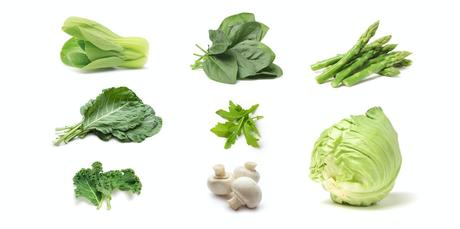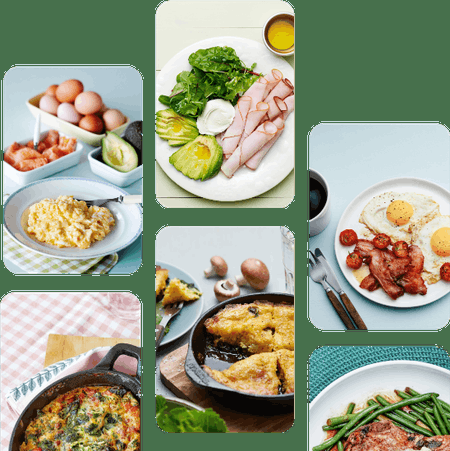Key takeaways
How to choose vegetables that promote weight loss? Focus on vegetables that provide plenty of protein per calorie and fit your dietary approach.Learn more Non-starchy vegetables are a good fit for all diets Leafy greens, cauliflower, green beans, zucchini, and many other vegetables contain protein and are low in carbs and calories - yet high in vitamins, minerals, and fiber. Find out more Starchy vegetables are a good fit for some diets Carrots, beets, onions, potatoes, and winter squash provide nutrients and fiber but are higher in carbs than non-starchy vegetables. Tell me more
You've likely heard that eating more vegetables is an excellent weight loss strategy. While this can be true, some vegetables may be better than others for losing weight.
The best vegetables for weight loss are the kinds that provide the most protein, nutrients, and fiber for the fewest calories.Fortunately, you can enjoy a wide variety of vegetables, no matter which dietary approach you follow. Selecting the types that best fit your preferred way of eating - and your health goals - is the key.
In this guide, you'll learn how to make smart vegetable choices that can help you lose weight in a healthy way. You'll also get recipes and tips for enhancing the flavors of different vegetables.

Get your personalized meal plan with a FREE 30-day trial!
What are the best vegetables for weight loss?
To lose weight and stay healthy, you need to take in less energy (calories) than your body requires in a way that improves your food-related hormone levels, while meeting your needs for essential nutrients like protein, vitamins, and minerals. It's also important to eat in a way that prevents you from getting hungry or feeling deprived.
Here is our list of the top 10 vegetables that can play an important role in healthy weight loss:Of course, many other vegetables can help you lose weight in a healthy way, too. We'll provide detailed lists of the different types, so you can see how your favorites rank. But first, let's explore healthy weight loss foods more generally.
What do healthy weight loss foods have in common?
The best weight loss foods maximize nutrition and satiety - that feeling of being comfortably full and satisfied - while minimizing calories.Some of the common threads among these foods include:
-
High protein percentage: Protein is an essential nutrient you need to consume every day to stay healthy. Plus, strong evidence confirms that getting plenty of protein can help you feel full, lose body fat, and prevent muscle loss. When choosing vegetables, go for those with high protein percentages.A food's protein percentage tells you how much of its calories come from protein rather than fat and carbs.
However, even if you select vegetables with high protein percentages, you'll only get a few grams of protein - at most - in a generous serving. Additionally, vegetables are low in at least one of the essential amino acids that your body requires daily.
So, although vegetables can be excellent additions to a weight loss diet, you can't rely on them alone to meet your protein needs. For healthy, sustainable weight loss, eat vegetables along with higher protein foods, such as meat, seafood, and eggs, dairy products, and plant-based proteins, such as soy and legumes (depending on your carbohydrate intake level).
- Low energy density: "Energy density" refers to the calories (or energy) in a specific weight of food. It is typically expressed as the number of calories per gram of food (calories/gram). The lower the number, the fewer calories a given amount of food contains.
In trials, people often end up taking in fewer calories overall when they mainly eat foods with low energy densities compared to foods with high energy densities. Foods with the lowest energy densities contain a lot of water, fiber, or both. This is because water provides zero calories per gram and fiber is estimated to provide less than 1 calorie per gram. Protein and carbs provide 4 calories per gram, while fat provides 9 calories per gram.
All vegetables have very low energy densities (less than 1 calorie per gram) because they're high in water and low in fat. They also provide fiber, which may be beneficial for weight loss, as discussed below.
-
High in fiber: Fiber, or roughage, is the non-digestible portion of carbs found in plants. Studies suggest that fiber can help people feel full, eat less, and absorb slightly fewer calories from mixed meals.
However, the people who participated in these trials were eating higher carb diets. So, if you are eating a keto or low-carb diet, it's possible that some of the potential benefits of fiber may not apply to you. On the other hand, since fiber is bulky and stretches the stomach, it may provide you with short-term satiety, no matter which dietary approach you follow.
All vegetables contain some fiber, although amounts vary among different types. Most vegetables provide between 1 to 4 grams of fiber per serving.
Choose vegetables that fit your diet and health goals
Fortunately, you can enjoy dozens of vegetables freely, regardless of the type of diet you eat. The other good news is that strong scientific support exists for many healthy weight loss approaches.
For example, keto and low-carb diets, which include greens and many other low-carb vegetables, can be highly effective for losing weight.
Mediterranean diets feature all types of vegetables and have been credited with helping people lose weight. Another effective weight loss strategy is eating a low-carb Mediterranean diet that contains mostly non-starchy vegetables.
A plant-based diet that provides a wide variety of vegetables may help people lose weight, too. You can also lose weight by following a low-carb vegetarian or vegan diet that prioritizes low-carb vegetables.
Finally, it's important to consider your health goals when you select vegetables. Consuming starchy vegetables, which are higher in carbs, may raise your blood sugar if you have diabetes or prediabetes.
To keep your blood sugar under control, choose mostly non-starchy vegetables. Or, if you want to eat some higher carb vegetables, test your blood sugar one to two hours after eating them. Doing this can help you determine the right amount for you.
Also, some people may experience abdominal pain, bloating, and other symptoms after eating certain vegetables. Minimizing vegetable intake may help reduce symptoms of IBS and other digestive issues.
How to choose vegetables for healthy weight loss
The very best vegetables for weight loss have protein percentages in the yellow and green columns. All vegetables have energy densities in the dark green column.
Below, you'll see two broad categories of vegetables: non-starchy and starchy. Each category is divided into subcategories, with vegetables listed from best to worst based on their protein percentage, energy density, net carbs, and fiber amounts.
In this guide, we provide nutrition information for the most common vegetables. These are based on average values. Protein, carbs, and fiber content can vary slightly depending on growing conditions and differences in vegetable varieties.
Non-starchy vegetables (mostly above ground)
Aside from radishes and a few other exceptions, non-starchy vegetables grow mainly above the ground. They generally have higher protein percentages and lower energy densities than their starchy counterparts, which grow mainly below the ground. And, with their low carb and calorie counts, non-starchy vegetables are ideal for all types of diets.
Salad greens
Spinach and other leafy greens are excellent for weight loss, for several reasons. For starters, most greens provide a lot of protein per calorie. Plus, they're extremely low in net carbs and high in fiber, which can help you feel full. Some greens contain more fiber than net carbs!
Finally, they are versatile, easy to prepare, and widely available. You can, of course, eat greens in salads, such as our Spicy shrimp salad. Another great option is using lettuce to wrap a burger or meat, like this exotic Keto thai chicken lettuce wrap.
Cruciferous vegetables
Cruciferous, or Brassica, vegetables include broccoli, cauliflower, kale, cabbage, and Brussels sprouts. When chopped or cooked, these vegetables release compounds that have a familiar and strong sulfur aroma. Other cruciferous vegetables are less odorous, such as bok choy, radishes, turnip greens, and collard greens.
All Brassica vegetables are low in calories and carbs, making them a great choice for any diet. Even if you're a strict keto eater, you can have a cup or more per day and stay well within your carb limit.
Cooking cruciferous vegetables enhances their taste and texture, especially if you add a little butter or creamy sauce, as we've done in our Keto cauliflower chicken Alfredo recipe.

Get your personalized meal plan with a FREE 30-day trial!
What's your main health goal?
"Fruit" vegetables
The non-starchy vegetables in this group are technically low-sugar fruits. However, they are not sweet, and they're often consumed in salads or cooked, like vegetables. So, most people consider them to be vegetables.
While they generally contain less protein per calorie than many leafy greens and cruciferous vegetables, these plants are still a great option for all types of diets due to their low carb and calorie counts.
Enjoy them cooked or raw, depending on your preferences. For example, cooked zucchini is featured in our Keto chicken zoodle al limone recipe, while raw tomatoes star in our Prosciutto-wrapped mozzarella sticks with tomato basil salad.
Other non-starchy vegetables
The vegetables on this list don't belong to any specific category, but like other non-starchy vegetables, they're low in calories and carbs yet rich in vitamins and minerals. Many of them have high protein percentages.
Mushrooms are technically not vegetables; they're fungi. However, mushrooms are often grouped with vegetables because they share similar nutrition profiles.
What about English peas, or shelling peas? They aren't included here because they are technically a legume and are considered a protein source rather than a vegetable.
Choose whichever vegetables you like from this group. Most should be cooked before you eat them, although mushrooms and celery can also be enjoyed raw. See our Hake fish in green sauce with wild asparagus and Keto chicken and mushroom casserole recipes for inspiration.
Starchy vegetables (mostly below ground)
Most starchy vegetables grow below the ground, including root vegetables like carrots, beets, onions, potatoes, and sweet potatoes. However, winter squash grows above the ground but is included in the starchy vegetable category due to its higher carb content.
Starchy vegetables have low energy densities because they contain very little fat and moderate amounts of water and fiber. However, their protein percentages are lower than non-starchy vegetables.
Should you include these vegetables in your weight loss diet? That depends on your dietary approach, your health goals - and the amount you eat. Learn more, below.
Root vegetables
Root vegetables are so named because they grow under the ground, like the roots of a tree.
Carb counts vary quite a bit among the vegetables in this group. If you eat a Mediterranean, vegetarian, or vegan diet, you may be able to enjoy a daily serving or two of any vegetables on this list.
However, on a keto or low-carb diet, you'll need to eat small portions of these vegetables, if any at all. Make your favorite non-starchy vegetables your go-to's.
Although carrots and onions can be eaten raw or cooked, most root vegetables require cooking prior to consumption. For a delicious seafood dish with a combination of root and non-starchy vegetables, try our Pan-fried cod with beet salad and brown butter.
Winter squash
As mentioned above, winter squash grows above the ground but is included in the starchy vegetable category. By contrast, zucchini, a summer squash, is considered a non-starchy vegetable.
Some types of winter squash, such as pumpkin and spaghetti squash, are lower in net carbs than many root vegetables. Therefore, if you eat a keto or low-carb diet, you can probably enjoy a small portion of most winter squash. If you follow a Mediterranean or plant-based approach, you can eat winter squash in larger amounts.
Like root vegetables, winter squash should be thoroughly cooked before it's consumed. For a hearty recipe featuring squash, try our Keto harvest pumpkin and sausage soup.
Meal plans designed for results
With our personalized meal plans, we do the planning for you. All you have to focus on is cooking, eating, and enjoying healthy, delicious food.

Healthy weight loss recipes featuring vegetables
As mentioned earlier, combining your favorite vegetables with protein is a smart move for healthy weight loss. And, adding a bit of fat can improve the flavor and texture of your meal. Check out some of our popular entree recipes featuring vegetables:

